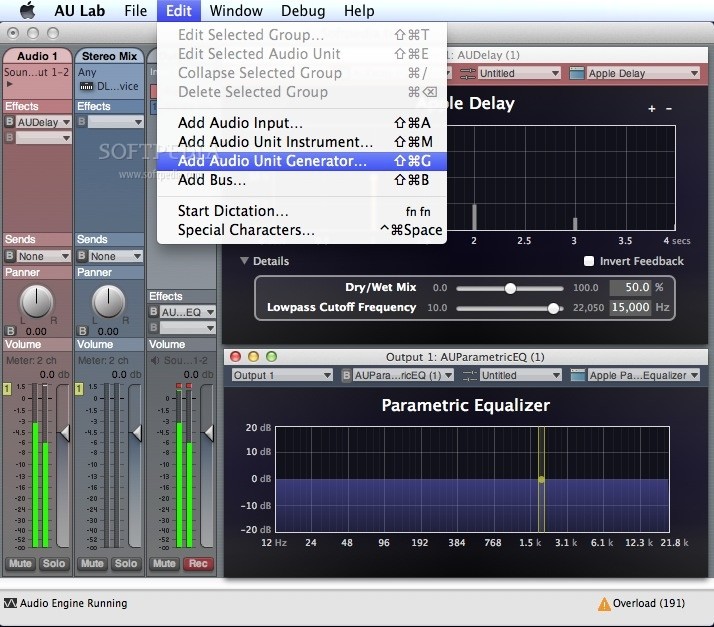X64 x86, vst au aax, win mac, 10mb Saturate is a simple saturation plugin. Usenet.nl/download/Blue Lab Saturate v5.0.1 X64 X86 VST AU AAX WiN MAC [FREE] download from any file hoster with just one LinkSnappy account download from more than 100 file hosters at once with LinkSnappy. If you don’t already have Logic or another Audio Unit host application, download AU Lab to get started with auditioning your audio, detecting peaks and clipping, and performing double-blind listening tests.
I have successfully routed my system audio through AU Lab via Soundflower, but it clicks. To my knowledge, that clicking sound usually means that buffer sizes are out of wack (either too small, or not consistent across any applications in the signal chain). Yet, trying to match the settings as follows doesn't seem to fix the problem. My settings:. In Soundflowerbed, buffer size = 2048.
In Info pane for AU Lab (CMD+i), selected 'Open in 32-bit mode'. In AU Lab preferences, buffer size of all devices = 2048. In System Prefs Audio Midi Setup, Format of Built-in Output = 44.1k, 32 bits, to match Soundflower. A few observations:. In AU Lab, regardless of what settings I've selected in Preferences, it shows the Frames settings of Built-in Output to be 512, which is not necessarily what I have it set to.
That figure gets updated for Soundflower. Not sure what that's about. Setting all buffer sizes to 512 to match the above does not fix the problem either. Clicking is present with all audio, consistently, and begins as soon as audio starts. If there is no audio, there is no clicking. In Audio Midi Setup, Soundflower says its audio is of the 32-bit integer variety, while the closest option Built-in Output has is 32-bit float.
I don't know enough about digital signal processing to know if that's an issue. I am on the Mid-2014 model MBP with OSX 9.4, Soundflower 1.6.6, and AU Lab 2.3. It's exactly the same here, periodic clicking, about 3 times a second. Sound like dropouts.
I don't think there's anything we can do:/ I've had the exact same setup working flawlessly in previous versions of OX, even Mavericks if I remember correctly. Apple broke it with 10.9.4. And when you look at the date of the public version, 2.2.2. It's from 2012. 2.3 is not public (beta?) and not working either.

Au Lab Download
Obviously it's no priority for Apple. On my system it doesn't click right away though, only after a while. There's a handful of temporary fixes that sometimes work for me:. Closing and reopening AU Lab and the application that is playing back the sound. In AU Lab, under 'Window' - 'Show Studio', then change the input and output channels, 'apply channel changes', revert to the right channels, apply again. The latter fix used to work all the time, now it doesn't.
It's all super random and frustrating. I really need it to work, cause I'm using an acoustics correction plugin. Now I'm fiddling with AU Lab 30 times a day.
One final observation: Certain applications are way more likely to start clicking. The most likely one is Safari content, Soundcloud in particular.
Download Au Lab For Mac Pro
Disabling Safari cache didn't help though (to be honest I have no idea why it should change anything, I just try everything). System info: Mac Mini i5 2011, 16GB Ram, 512GB 840 Evo SSD, OSX 10.9.4, AU Lab 2.3, Soundflower v1.6.6, Motu 828 Mk1.
I'm having exactly the problem described above - with Yosemite, all the latest versions of everything, 64 bit mode, 2048 frames, etc. I've tired every fix, messed with all the parameters, and still a persistent clicking noise and overloads from AU Lab - even when running no other applications AND no effects or plugins at all.
Au Lab For Mac 2.2 Download
Just running audio though SoundFlower - AU Lab messes it up. So, I guessing, something deeply wrong in CoreAudio.
Very frustrating as I put a lot of time into RTA EQ profiles using AU Lab. My work-around for the moment is to use Adobe Audition for EQ. Run audio through a dummy multi-track session, monitor a stereo track, and use an EQ Effect. Overkill, but it works well - and you can play adjust the wet/dry mix which is nice.